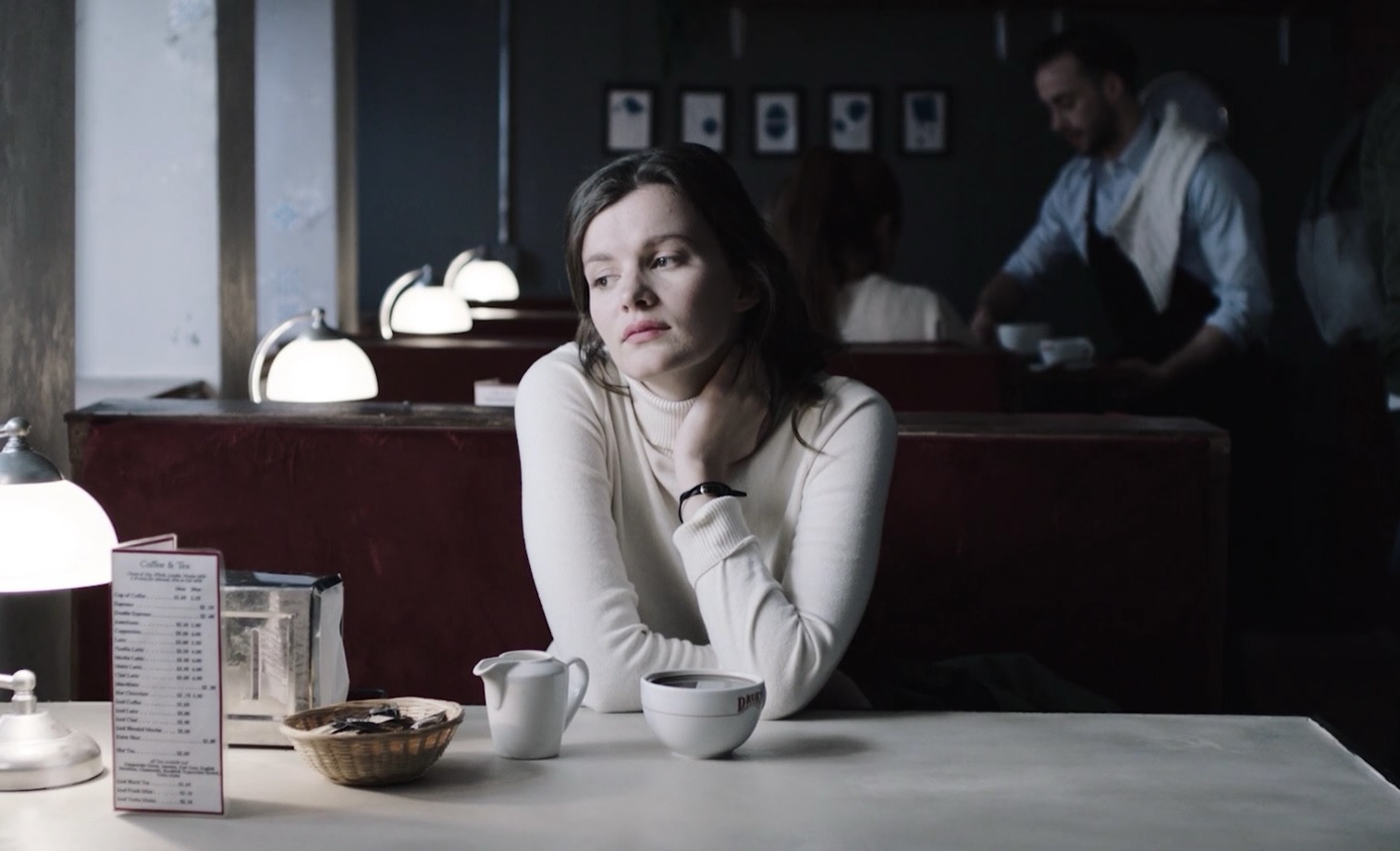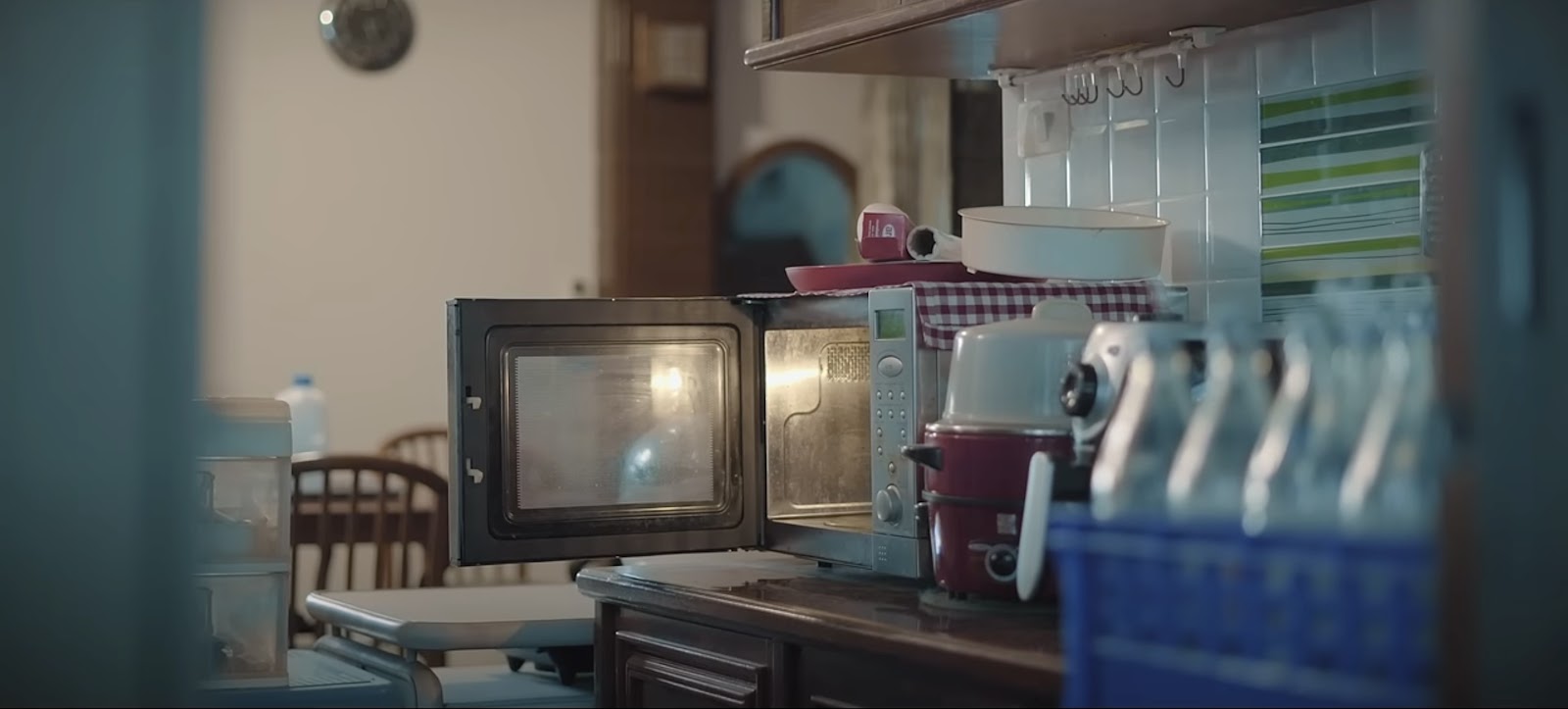'The Arrival' (2016)
Coursework 7
‘The Arrival’ explores themes of internal conflicts and the uncertainty of motherhood. The film heavily relies of its cinematic techniques to convey the emotions and thoughts of Anna, the protagonist, without solely relying on her voice over.
The film opens with J sound which is then followed by a blurred shot of Anna in the café which is created through the frost on the window. This is an effective way of establishing mood, tone and setting in a fast time frame which is useful due to the short duration of the film. The day appears to be ordinary, but the frosted window suggests to the spectator that her mind is clouded, and she is uncertain about the decision she is about to make. This is very useful as within the first few seconds we are invited to understand Anna’s psychological struggles without taking too much time out of the narrative to set up the story. As well as this, pathetic fallacy is consistently used throughout to emphasis Anna’s thoughts in the narrative. The grey and dreary weather at the start as she is riddled with uncertainty, then darkness when her conflict deepens, and finally sun light fills the café as she decides to keep the baby.
Particularly at the start, the film invites interpretation rather than giving the spectator straight answers. This could be reflecting that Anna isn’t even sure herself of the answers bringing us on this journey of uncertainty with her. The narrative is a basic structure which appears to adopt Syd Field’s three act structure: the setup, the confrontation and the resolution. This nicely fits with ‘The Arrival’ which travels through this structure rather quickly in its short narrative. The film also uses enigma codes at the beginning such as her saying she is going to have a caffeinated coffee which is then discovered by the spectator is due to her not keeping the baby. Her decision at the end of the film to have a decaf is a clever way of communicating to the spectator that she is keeping the baby. As the narrative lacks excitement due to its simplicity, the cinematography brings spectator engagement.
The camera helps to further articulate Anna’s feeling to the spectator. The long take as the camera slowly and gradually zooms in on Anna helps reflect her stress and anticipation as she waits to deliver difficult news. Effectively mirroring her stress and growing uncertainty. She remains strongly positioned in the frame. Her central position in the composition could be reflecting her indecisiveness as she is stuck in the middle of the two possible choices: keep it or don’t. The shift in the cinematography as she enters the ‘confrontation’ part of the narrative allows the spectator to clearly see how uncertain she is. The low contrast and muted colour palette of blues and greys is consumed by low lighting and heavy shadows highlighting the darkness and emotional burden of the decision. The chiaroscuro on her face nicely demonstrates her feeling of indecisiveness which is similar to ‘Slap’ which also heavily used lighting to effectively convey the feelings of the protagonist. Both using flashes of red lights creating a sense of danger and alarm.
There are no breaks in the editing as the film appears to be one continuous shot. This could be reflective of there being no breaks in the overwhelming feeling Anna is facing as she confronts the idea of her being a mother. Like ‘Operator’, the film takes place in the same setting using the camera to add context to the protagonists’ inner conflicts. The camera adds the essence of the film enhancing a simple narrative.
The train which is heard outside of the café as she gets lost in her thoughts could be a metaphor for her thoughts reaching a new destination. Her previous stop was doubt and a list of negative reasons of having a baby. The next stop a dreamlike fantasy view of a happy life with a baby by her side. The train could be symbolic of her character journey through her thoughts to get to her final solution bring to life the term ‘thought train.’
Originally, we are positioned to believe that the film will be a discussion between to unexpected parents about the decision to not have a baby however our expectations are subverted as she decides in the end to keep the baby and the man never showed up. The misleading narrative is similar to ‘Echo’ which led us to believe that Caroline would escape her harmful cycle of grief. A connection of trust is created between the spectator and Anna as the non-diegetic voice over adds insight and understanding of her thoughts allowing for a deeper emotional connection also the camera which is slowly moving closer to her making us in much closer proximity to her. It seems almost as though Anna is inviting us into her mind allowing us to join her on her psychological journey as she battles with a difficult dilemma.
At the end of the film the lighting and colour palette shifts one more to be much brighter and saturated which is enhanced by her radiating expression of happiness. Reassuring the spectator that she is happy with her change in heart and is much happy in the choice of having a baby. The baby saved her from the darkness of being lonely which is conveyed through a dull and boring café. The narrative shows character development as she is confident and stable in her decision. Like ‘Echo’, ‘The Fly’, ‘Operator’ and ‘Slap’, ‘The Arrival’ explores the discourse of internal conflicts and how it can lead to isolation. Its focuses on the battle women face about becoming mothers and highlights the difficult and high expectations women are set to be the perfect maternal figure.
Like ‘Over’ and ‘Operator’, ‘The Arrival’ is inspired by a true story. The filmmaker drew inspiration from a photograph and explored how it made him feel. This is something I found interesting as film inspiration is all around us sometimes in places we wouldn’t expect. The connection being made through the camera could be reflective of the director’s own attempts to enter the thoughts of the woman in the photograph. The film feels authentic, and I like that there is truth to the narrative that some spectators would find very impactful. The realness to the film makes it feel like a documentary through its honesty. I think having real life input and views into a film adds depth and allows the spectator to be positioned to feel deeper and take something meaningful from the film.



Tremendous! Perceptive, sensitive, engaging. Well done again
ReplyDelete